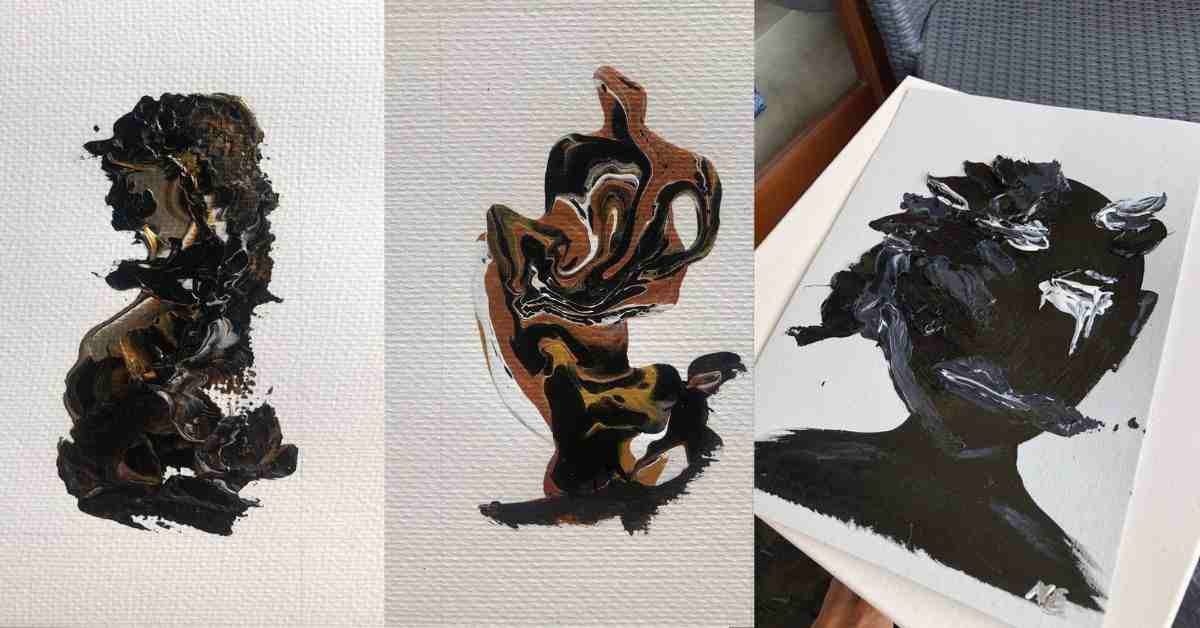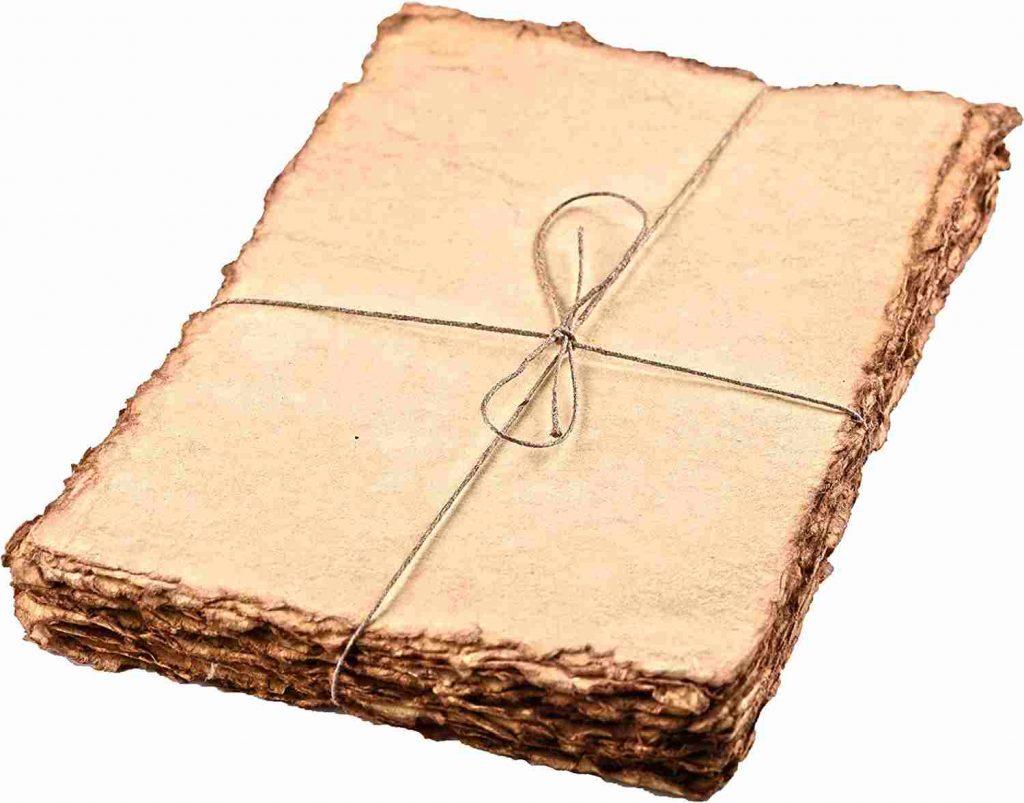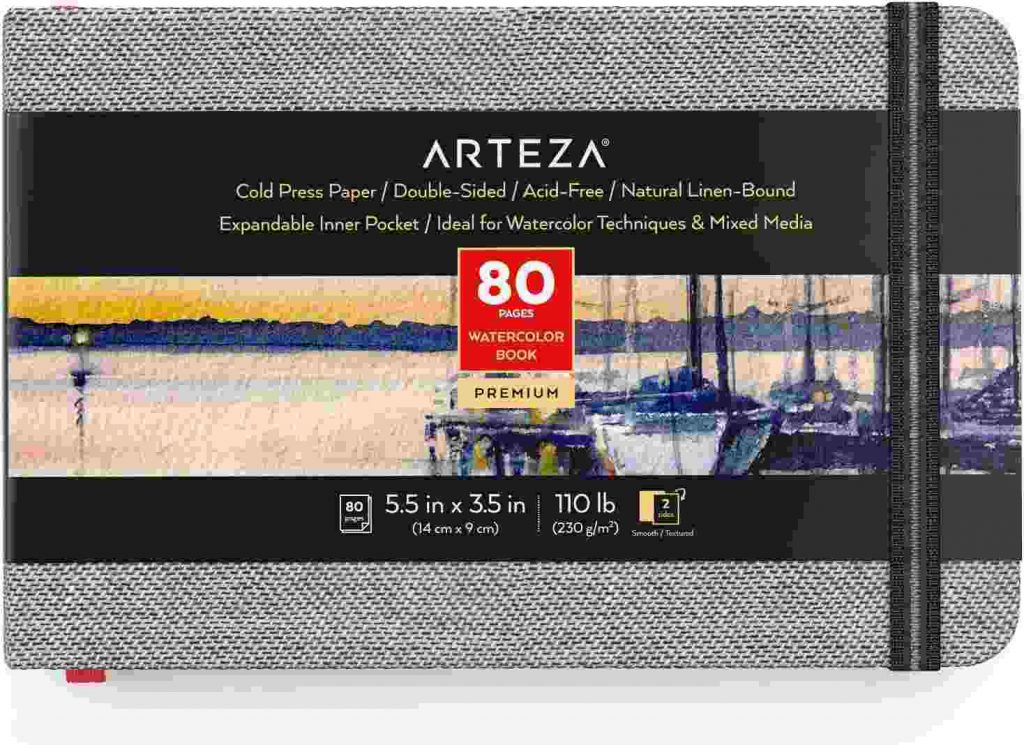Last Updated on November 19, 2023 by Masha Eretnova
If you are a fan of both watercolor and acrylic, you may want to experiment using both mediums. Will they work well together? Can you use acrylic paint on watercolor paper? Yes, it is possible!
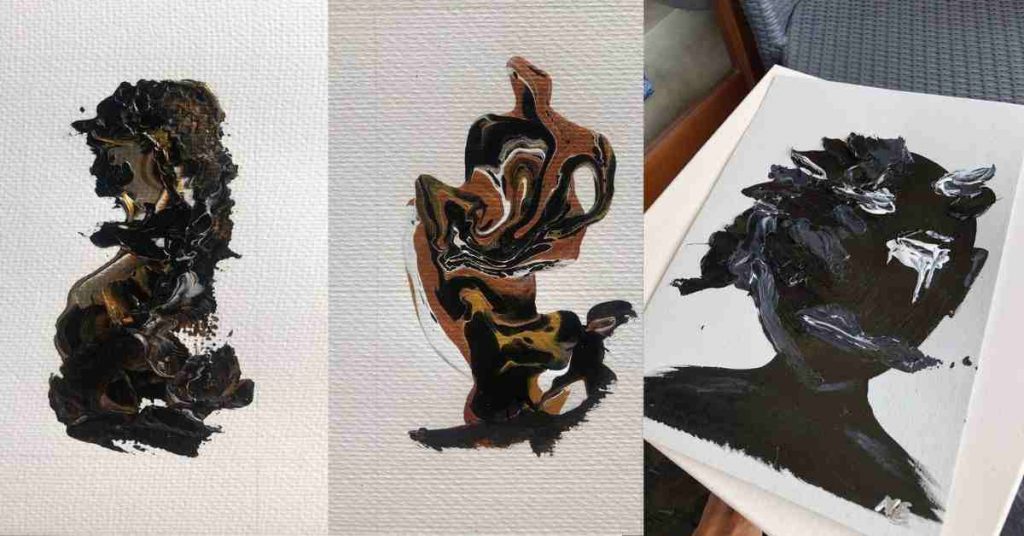
Using acrylic paint on watercolor paper is a definite yes! Watercolor paper is an excellent surface to apply acrylics. It is recommended to use heavy watercolor paper weighing 246-300 lb for acrylic painting because it is highly absorbent and will not bend.
I’m sure you are getting intrigued and want to know more about how you can use acrylic paint on watercolor paper. Do keep reading to discover how you can use acrylic paint on watercolor paper for the best results.
Table of Contents
Can you use acrylic paint on watercolor paper?
Yes, you can certainly use acrylic paint on watercolor paper. The texture of the watercolor paper is very absorbent and will not make your paint bleed. Watercolor paper is a great surface for acrylic paint because acrylics can be diluted with water the same way as watercolor paint.
In choosing the best watercolor paper for your acrylic painting project, you should go for the ones that are heavy. Heavy watercolor paper weighing around 246-300 lbs is highly recommended for quality acrylic painting results. Heavy watercolor paper can absorb more water and paint moisture.
For little art projects I’m even using 230gsm acid-free watercolor paper like this, it is super cheap where I live now:

I adore painting with acrylics on watercolor paper, especially if the paper has a nice velvety texture, it adds so much charm to the painting! It is also quite cheap and comes in handy when you have ready-to-use paper sheets of A5 – for quick painting and practicing it is a must!
Read also: Watercolor vs Acrylic: 21 Differences Between Acrylic and Watercolor
Why use acrylic paint on watercolor paper?
Using acrylic on paper is easier, faster, cheaper, and a better way to practice and do quick paintings.
Many artists like to use acrylic paint because it is an easy medium to work with. If you are a beginner, you may find using acrylic paint a breeze. There are several great characteristics of acrylic paint that make it special and widely used by many. Acrylic paint is fast drying and can be applied on paper very easily.
If you use watercolor paper, you can easily skip the priming stage. You just add water to the paint until it reaches the consistency you desire. Thus, brushing acrylic paint on watercolor paper will be easier to do.
Also, using paper is an amazing way to practice your painting techniques. Whether you are a beginner or a professional, you will find using paper convenient to use and relatively cheaper than using canvases.
How to choose watercolor paper for acrylic paint?
Before you get all excited about using acrylic paint on watercolor paper, there are some points that you have to keep in mind. The size of the paper, its weight, as well as the method of paint application all contribute to how well the paint sits on the paper.
The size of the paper you will use will matter for it defines how big or small your subject, your strokes and everything else will be. The size of your painting is part of the story of the painting. It provides the impact needed to move your audience.
Sheets or sketchbook
You can find separate sheets in packs or sketchbooks on the market. While there will be no difference in quality, it is a matter of what is more convenient to use for you. A4 Watercolor pads are the most popular option on the market.
I personally prefer sheets. I take one, I paint, and I set it aside. Also, some watercolor paper sheets come soooo cool, with burnt-like old-paper style edges. It looks just so nice!
Sketchbooks though are pocket-friendly. In some sketchbooks today there are cutting lines so you also can separate the sheet easily without ripping the whole album off. Watercolor pads are much more convenient as each sheet is easy to remove from the album and they are quite thick.
A less popular option is a watercolor paper block. They are mostly made of 100% cotton and the weight varies from 140lb to 300lb, but most importantly the sheets are glued on all 4 sides and not only on one like with pads. Such paper tends to be more durable, scratch resistant, and performant. Good choice for pro artists.
Paper Size
Here are the common paper sizes for your reference:
- A0 (841 x 1189 mm)
- A1 (594 x 841 mm) – love using this size for medium to large abstract practice paintings
- A2 (420 x 594 mm)
- A3 (297 x 420 mm)
- A4 (210 x 297 mm) – standard size, easy to frame.
- A5 (148 x 210 mm) – my favorite for small artworks!
- A6 (105 x 148 mm)
- A7 (74 x 105mm)
A3 and A4 paper sizes are the most common paper sizes used for painting. The size is just right to showcase your painting details. Also, you can easily find a frame for your painting in this paper size. For watercolor paper, the basic paper size is 558.8 x 762 mm (22” x 30”).
Paper Weight
The weight of the paper matters for this will define how much buckling or warping you can expect from your painting. This also defines how well it can absorb water and paint moisture.
Here are the common watercolor paper weights:
- 190 gsm (128.38 lb)
- 300 gsm (202.70 lb) – I use this most of the time
- 356 gsm (240.56 lb)
- 638 gsm (431.08 lb)
In North America, common watercolor paperweights are:
- 90 lb
- 140 lb (300 g) (most popular watercolor paper weight)
- 300 lb (640 g) (most preferred watercolor paper weight)
- 1,114 lb
Painting Technique
Paint is applied to decorate a surface and also protect it from chemicals, humidity, abrasion, UV rays and so much more. There are different methods of paint application such as spraying, dipping, or flow coating. You should be able to determine which application method is best for your work and easier for you to manage.
I recommend using watercolor paper with acrylics for dry brush technique, wet-on-wet, small pours, and wet-on-dry techniques. If you like mixed media, you can work with acrylics, tempera, poster paint, markers, pencils, watercolor, and gouache on watercolor paper as well!
If you are planning to use water or pouring paint, use watercolor paper with at least 300 gsm.
Depending on the size of the paper, choose the appropriate size of the brush, I use 1/4, 1/2, 1 flat, and round brushes when painting on A4 and A5 paper.
Learn everything about paintbrushes: The Best Brush for Acrylic Paint on Canvas
What is the difference between watercolor and acrylic paper?
Acrylic and watercolor papers are different in use, texture, and paper color.
- The first notable difference between watercolor paper and acrylic paper is its primary usage: watercolor or acrylic paint. The acrylic paper should be able to hold the weight of acrylics without bending.
We can use acrylic on watercolor paper, but some painters say that watercolor paint on acrylic paper won’t work as some acrylic paper may be gessoed.
The composition of both papers is very similar as well as common sizes and weights. Acrylic paper is made of cellulose, is acid-free, and may contain linen. Watercolor paper is also acid-free, made of cellulose, cotton, linen, or a mix of all (It will affect the price).
2. Texture. Acrylic paper is embossed with a canvas-like pattern or can be absolutely flat. Watercolor paper on the other hand has three surface types – rough, hot-pressed, and cold-pressed.
Rough watercolor paper has a textured feel while hot-pressed watercolor paper is very smooth. The cold-pressed watercolor paper has a slightly textured finish but is not as smooth as hot-pressed ones.
3. Color. Another difference between these two papers is their surface color or tinting. Acrylic paper often has an off-white surface appearance. The watercolor paper, on the other hand, comes in either white or cream color.
Sometimes watercolor paper comes in vintage style when it is tinted burnt, greyish, or pearl white.
For a visual comparison, you may want to look at the watercolor paper and acrylic paper brands below. You may click the link to see how these papers look in detail.
Some acrylic papers also tend to be more expensive than watercolor paper.
How to do acrylic painting on watercolor paper?
Before you begin painting on watercolor paper, listed below are the supplies you need to have on hand as well as the procedure on how to apply acrylic paint on watercolor paper.
Supplies for painting acrylic on watercolor paper:
- Acrylic paint
- Watercolor paper
- Drawing board (optional)
- Paintbrushes
- Artist palette
- Rag or paper towels
- Container with water
- Gesso (optional)
Acrylic paint
You should definitely get good-quality acrylic paint. Good quality acrylic paint allows you to experiment well with its consistency. You can add as much water as you like making it fluid like watercolor or have a thick solid color as how it comes out of the tube.
In choosing acrylic paint, it is advisable to get artist-quality ones. If you are a beginner, it can be tempting to buy student-quality paints because they are cheaper. If you work on paper, choose soft-bodied paints as the heavy body may be too heavy, especially if you will apply them in thick layers.
If you are starting out, you don’t need a lot of colors to begin painting with acrylic. You can initially start with 6-10 basic colors which you can mix and experiment with to make new colors. Here is an article you can read on how you can blend acrylic paint.
The only time you can buy more colors is when you feel that mixing 2 or more colors cannot give you the color vibrancy that you are looking for. Doing this can save you money in the long run.
- Quality watercolor paper
It is highly important that you use high-quality and durable watercolor paper for acrylic painting. Aim for 300gsm at least. Excellent quality watercolor paper reduces buckling and warping.
If possible, you should get professional-grade watercolor paper from brands like Canson, Arches, or Strathmore. This type of watercolor paper is made of cellulose, 100% cotton, and synthetic fibers.
You may also want to check out watercolor blocks. Many experienced and professional artists use watercolor blocks because they come in different sizes which is very convenient when choosing the size you want for your painting.
If you have lightweight watercolor paper, you could use watercolor blocks to keep your work from buckling or warping. These watercolor blocks or watercolor boards contain watercolor papers that are stacked together.
The edges of the watercolor paper are taped securely underneath. Doing this limits the chance of curves or curls developing around the edges. This way, your painting stays flat and stretched until it is finally dry.
Now that you know that it is important to purchase high-quality and durable watercolor paper. It is time that you check the right weight for the watercolor paper that you will purchase. When choosing your watercolor paper, choose the ones that are 246-300 lb heavy. Thick and heavy watercolor paper can absorb water well and buckling is highly reduced.
- Gesso (optional)
Gesso is a base coat used for artwork. It is a white mixture that is applied first on paper or canvas. This doesn’t hamper the color quality of your work. Applying a thin coat of Gesso both at the front and back parts of your paper can help prevent bleeding.
Though, applying gesso is not required and can be an added expense, especially for beginners. You can still proceed with painting on watercolor paper without gesso and still get quality output. You can read this article to know more about Gesso and how you can make your own.
How to prepare watercolor paper for acrylic painting?
If you are a beginner and you are still experimenting with different paints and mediums, you may want to do a test first on an extra sheet of regular printer paper. You can try out how diluted you want your acrylic paint to be.
Testing it out on a separate sheet of paper will allow you to experiment with your painting techniques as well as the heaviness of your application. This will give you an idea if your work will buckle or not after drying.
How to apply acrylics on watercolor paper
Step 1: Position your paper
Lay your drawing board on a clean and flat working surface. The watercolor paper should be positioned at the center of the board. On all four edges, tape the watercolor paper in place. The tapes should be evenly placed on all four corners. It should cover at least ½” of the watercolor paper.
This step is optional as I’m painting on paper just on my table, but I do cover it with plastic or flat plastic board that I have just to protect the table itself.
Step 2: Applying the Gesso (optional)
In a large and clean container pour a generous amount of gesso. To thin out the gesso, add a tablespoon of water. Stir the mixture for a few minutes until you get a yogurt-like consistency. Applying a thin layer of gesso on both sides of the paper is enough to prevent the paper from warping or buckling.
This step is optional as most artists don’t gesso the paper and it doesn’t make sense to do so if you are just practicing or having fun.
Step 4: Painting
When you have finally decided on the dilution level of your paint as well as the painting technique, it is time to begin painting with acrylics. Make sure your watercolor paper is taped in place. You can gently remove the tape when you are done painting.
Step 5: Sealing
You can seal your painting with a sealant that is water-based. You need to let your painting completely dry first before applying a sealant. You may seal your painting with Krylon Gloss UV-Resistant or Mod Podge spray acrylic coating.
Apply only a thin layer and let it dry for 30 minutes at least.
What to do when buckling happens?
Once your work has dried unevenly in different areas of your painting, buckling can occur. Buckling can happen when you are using acrylic paint in thick layers or too runny on watercolor paper.
Aside from buckling, it is important that the watercolor paper will not warp. If buckling does happen, don’t feel disheartened because you can easily remedy the situation.
One known remedy is:
- laying your work on a clean and flat surface and spraying it with water to add moisture to the back of your work. Do keep in mind that you need to spray with enough water only. Spraying too much water can trigger the water solubility of the other paints you used.
- Once done, you must cover your work with a clean towel, cardboard, wax paper, or glass.
- Leave a heavy object over the covered painting overnight to keep your work flat.
6 Best Watercolor Papers for Acrylic Painting
It is really best to use quality watercolor paper for your acrylic painting. The paint will easily be absorbed and buckling will be minimized. When choosing the ideal watercolor paper for your acrylic painting, there are several factors to consider such as:
- Heavyweight for best absorbency of water and moisture
- Durable and not easily torn
- Acid-free
- It should not be prone to discoloration
- Do not use smooth, oily, or glossy paper surfaces
Here are some of the recommended watercolor papers for your next acrylic painting project:
| BEST OVERALL Canson Paper Pad | RUNNER-UP Strathmore Watercolor Paper | UCreate P4943 Watercolor Paper | Yupo Paper | Arches Watercolor Block | Arteza Watercolor Paper | |
|---|---|---|---|---|---|---|
 | 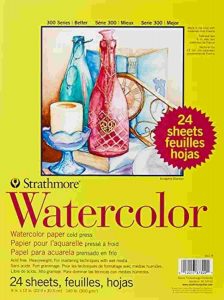 |  | 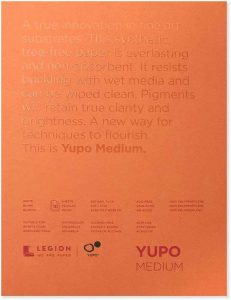 |  | 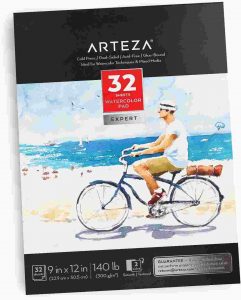 |
|
| Composition | cold pressed paper | cold-pressed acid-free paper | acid-free sulphite paper | 100% Polypropylene, Acid Free, tree-free, Neutral pH (basically it is a non porous plastic sheet) | 100% Cotton Paper, gelatin sized Available cold and hot pressed | Cold Pressed, Acid Free Paper |
| Texture | natural texture | no | no | no | fine natural grain | no |
| Size | 9" x 12" | 9" x 12" | 9" x 12" | 9" x 12" | 9" x 12" | 9" x 12" |
| Weight | 140 lb | 140 lb | 140 lb | 74 Lb | 140 lb | 140lb / 300gsm |
| Sheets | 30 | 24 | 50 | 10 | 20 | 32 |
| Type | paper pad | paper pad, student-grade paper | paper pad | paper pad | artist-grade watercolor paper block | |
| Color | white | white | white | white | white | |
| Buckling | no | no | slight | no | no | slight |
| Price | around $12 | around $10 | under $20 | under $20 | around $40 | around $15 |
Best Overall – Canson XL Watercolor Paper
Absolute bestseller online and offline, one of the leading brands on the market – Cranson Watercolor Paper. Canson paper has a natural grain and natural white color, it is an acid-free, cold-pressed smooth paper for watercolor, acrylics, and mixed media.
You can choose album or vertical format, and different sizes: 9×12”, 11″ x 14″, 12″ x 18″, and 18″ x 24″. 30 sheets in the pad – a good number for a monthly panting challenge 🙂
Price is also very affordable – around $10-12 depending on where you will buy it from.
Strathmore 300 series Watercolor Paper – Runner up

The Strathmore 300 series watercolor paper is famous among watercolor enthusiasts. Strathmore allows you to achieve fine and even applications. It has a cold press surface which makes it great for working on your watercolor skills. With its strong surface, you can do scraping and lifting applications.
You can buy the 300 series or its best brother 400 series – this one is even more durable. In the 300 series, there are 24 sheets and in the 400 series, there are only 12 sheets.
Available sizes are numerous from 5.5×8.5 inches to 18×24 inches.
Same as Canson, Strathmore is a popular and high-quality brand, and they actually do a crazy wide range of papers for different purposes from sketching to canvas pads for painting. And they can be even cheaper than Canson but within the same range – around $10. Highly recommend!
UCreate P4943 Watercolor Paper
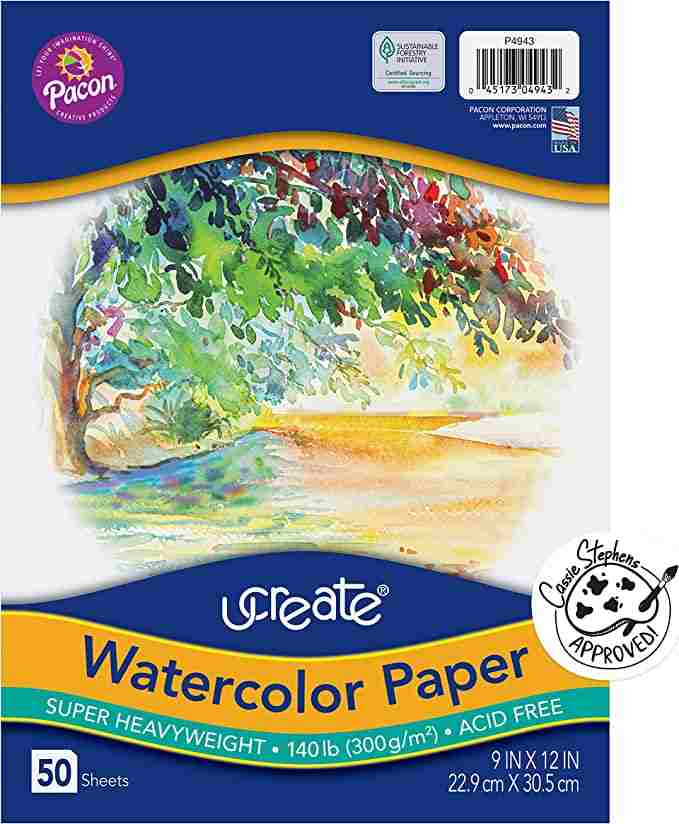
The UCreate watercolor paper is perfect for your next painting project for it is 140 lb thick, perfect for water absorption. Buying a pack of UCreate includes 50 pieces of 9×12” watercolor paper that is of premium quality.
Big pro – this pack has the biggest number of sheets for such a price on the market.
You will like using UCreate watercolor paper because it is environmentally friendly and completely recyclable. This acid-free watercolor paper is great for children, adults, beginners, and experienced artists. UCreate Paper is highly versatile for you can use either acrylic or poster paint on it.
Yupo Paper – Best for acrylic ink

Yupo is a synthetic and tree-free paper and it is not really a paper. It is made of polypropylene which is plastic so the surface is absolutely nonabsorbent and nonporous, unlike paper. Yupo paper is best for acrylic inks and bright artwork.
Yupo is recyclable, highly durable, waterproof, and tear-resistant. As a beginner, you don’t have to worry about making a mistake because you can easily wipe the paint off. You also won’t have to worry about buckling issues.
Arteza Watercolor Paper

Arteza is a huge art supply brand for beginners. Arteza watercolor paper is a good quality student-grade paper with only slight buckling.
The brand sells paper pads on spirals or glued, but also watercolor paper cards and watercolor pocket sketchbooks that are useful for travel and Plein air. Sizes thus vary from 5.5×8.5 inches to round paper. 9×12 inches 140 lb paper is a popular choice for beginners, and the pack has a good amount of sheets – 32.
Arteza watercolor paper has amazing reviews online but most people are wondering why it is more expensive than some professional brands and it is a fair point.
Arches Watercolor Block – Professional Choice
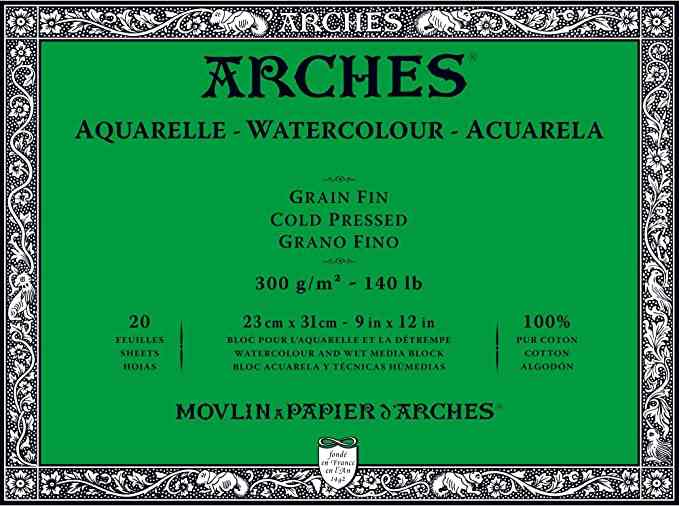
If you are looking to upgrade your painting supplies, you can buy Arches paper – the brand is known among professional watercolor painters and mixed media artists for high-quality and durable papers.
This watercolor block will be much more expensive than paper pads but it is also more durable and is made of 100% cotton which gives a natural canvas-like texture and white-ish color. It is also the only paper on the market that is gelatin sized and all four edges are glued.
Available in cold or hot press, and also rough texture, and also in 13 sizes.
Perfect for gouache, acrylic painting, and inks and professional artists.
Frequently Asked Questions
There are tons of amazing watercolor paper on the market. It can be overwhelming to choose the best one. The best person to define which is best is you. If you want to grow as an artist, you should experiment and try out different types of paper and paint. Only then would you know which one suits you best.
Can you mix acrylic paint with watercolor?
Yes, you can mix acrylic paint with watercolor paint. Many artists have used this technique because the combination of these two paints produces a distinct color that looks really good. You can experiment with the two paint types to determine the ideal proportion for your mix.
What happens when acrylics are mixed with watercolor paint?
When mixing acrylic paint and watercolor paint the possibilities are limitless. You can easily experiment with these two paint types. If you mix acrylic paint with watercolor paint you can make artwork that has a watercolor-like texture and the opacity of acrylic paint.
Wrap Up
As an artist, you like to explore different types of paint and paper. It is best that you experiment and find the materials you are more comfortable working with. If you are a beginner, you should definitely give acrylic paints a try for these are easy to use and can be applied on any surface.
If you want to use acrylic paint on watercolor paper, do get durable and high-quality ones. You should purchase heavy watercolor paper for high absorption of water and moisture. When you are able to do this, you can be assured of fantastic results.

Masha Eretnova, born in 1991, is a Buenos Aires-based certified teacher, artist, and member of the Professional Artist Association with 20+ years of personal painting journey.
She started painting and drawing very early and is now an international abstract artist and educator passionate about acrylic painting, gouache, and crafts.
Her works are part of international exhibitions and contests, including ArtlyMix (Brazil), Al-Tiba 9 (Spain), Exhibizone (Canada), Italy, and many more.
Besides her artistic pursuits, Masha holds a post-grad diploma in Teaching Film Photography and 2 music school diplomas: piano and opera singing.
